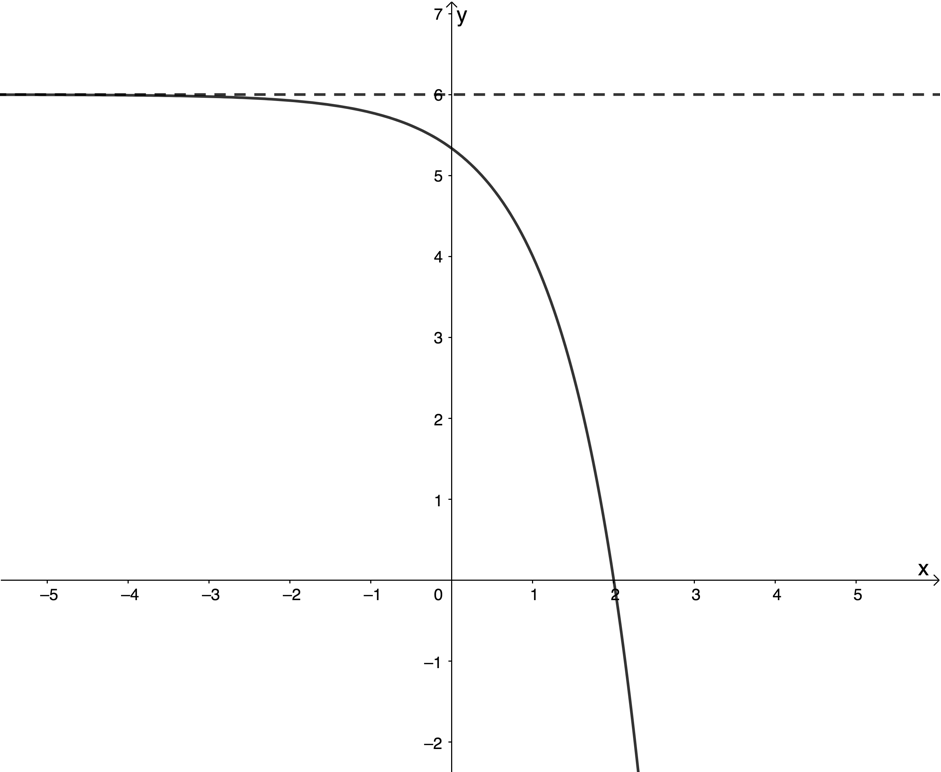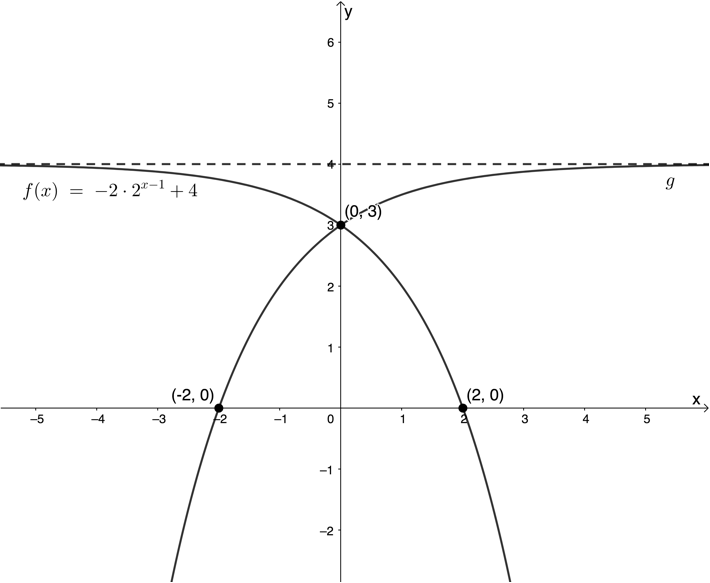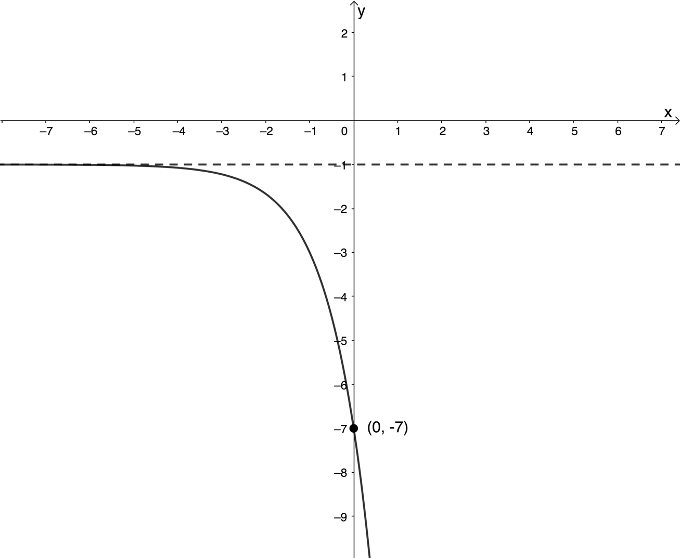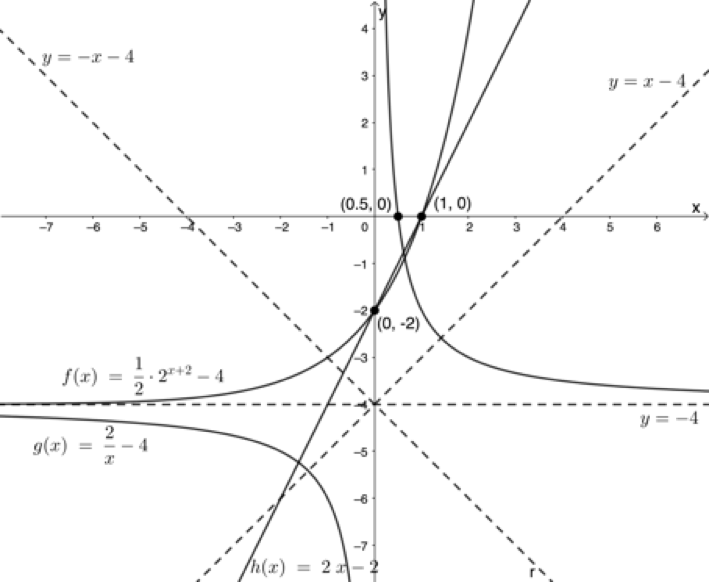Functions and algebra: Use a variety of techniques to sketch and interpret information from graphs of functions
Unit 6: Find the equation of an exponential function
Dylan Busa
Unit outcomes
By the end of this unit you will be able to:
- Find the equation of exponential graphs in the form [latex]\scriptsize y=a.{{b}^{{x+p}}}+q,\text{ }b \gt 0[/latex].
- Analyse exponential functions.
What you should know
Before you start this unit, make sure you can:
- Solve linear simultaneous equations. Refer to level 2 subject outcome 2.3 unit 4 if you need assistance.
- Determine the domain and range of exponential functions of the form [latex]\scriptsize y=a.{{b}^{{x+p}}}+q,\text{ }b \gt 0[/latex]. Refer to unit 5 in this subject outcome if you need assistance.
- Find the asymptote of exponential functions of the form [latex]\scriptsize y=a.{{b}^{{x+p}}}+q,\text{ }b \gt 0[/latex]. Refer to unit 5 in this subject outcome if you need assistance.
- Find the intercepts with the axes of exponential functions of the form [latex]\scriptsize y=a.{{b}^{{x+p}}}+q,\text{ }b \gt 0[/latex]. Refer to unit 5 in this subject outcome if you need assistance.
Introduction
In the previous unit we learnt how to determine various characteristics of exponential functions of the form [latex]\scriptsize y=a.{{b}^{{x+p}}}+q,\text{ }b \gt 0[/latex] in order to sketch their graphs.
These characteristics included:
- the general shape of the graph, affected by the values of [latex]\scriptsize a[/latex] and [latex]\scriptsize b[/latex]
- the domain and range
- the asymptote
- the intercepts with the axes.
In this unit, we will see how we can use these characteristics from the graph of an exponential function to determine the equation of the exponential function.
Find the equation of an exponential function
To find the equation of an exponential function of the form [latex]\scriptsize y=a.{{b}^{{x+p}}}+q,\text{ }b \gt 0[/latex] from its graph, we need to find the values of [latex]\scriptsize a[/latex], [latex]\scriptsize b[/latex], [latex]\scriptsize p[/latex] and [latex]\scriptsize q[/latex].
We can always determine whether [latex]\scriptsize a \gt 0[/latex] or [latex]\scriptsize a \lt 0[/latex] and whether [latex]\scriptsize b \gt 1[/latex] or [latex]\scriptsize 0 \lt b \lt 1[/latex] by looking at shape of the graph. Does it increase or decrease as [latex]\scriptsize x[/latex] increases or decreases?
We can determine the values of [latex]\scriptsize p[/latex] and [latex]\scriptsize q[/latex] by looking at:
- the asymptote (remember the horizontal asymptote is the line [latex]\scriptsize y=q[/latex])
- the intercepts with the axes.
Because we have four unknowns to find, we require four pieces of information. Very often, you will be given one, or even two, of the values of [latex]\scriptsize a[/latex], [latex]\scriptsize b[/latex], [latex]\scriptsize p[/latex] and [latex]\scriptsize q[/latex].
Let’s look at some examples.
Example 6.1
Question taken from Siyavula Grade 11 Mathematics Worked Example 17 pg 192.
The graph below is an exponential function of the form [latex]\scriptsize y=-2\times {{3}^{{x+p}}}+q[/latex]. Determine the equation of the function.

Solution
We are given that [latex]\scriptsize a=-2[/latex] and [latex]\scriptsize b=3[/latex]. We can see this in the shape of the graph. It decreases as [latex]\scriptsize x[/latex] increases.
We have also been given that the horizontal asymptote is the line [latex]\scriptsize y=6[/latex]. Therefore, we know that [latex]\scriptsize q=6[/latex]. Therefore, the equation of the exponential function is [latex]\scriptsize y=-2\times {{3}^{{x+p}}}+6[/latex].
We are also given that the x-intercept is the point [latex]\scriptsize (2,0)[/latex]. We can substitute this point into the equation to solve for [latex]\scriptsize p[/latex].
[latex]\scriptsize \begin{align*}0 & =-2\times {{3}^{{2+p}}}+6\\\therefore 2\times {{3}^{{2+p}}} & =6\\\therefore {{3}^{{2+p}}} & =3\\\therefore 2+p & =1\\\therefore p & =-1\end{align*}[/latex]
The equation of the function is [latex]\scriptsize y=-2\times {{3}^{{x-1}}}+6[/latex].
Example 6.2
Sketched below are graphs of [latex]\scriptsize f(x)=-{{2.2}^{{x-1}}}+4[/latex] and [latex]\scriptsize \displaystyle g(x)=a.{{b}^{{x+p}}}+q,\text{ }b \lt 0[/latex] where [latex]\scriptsize g(x)[/latex] is symmetrical to [latex]\scriptsize f(x)[/latex] about the y-axis. Determine the values of [latex]\scriptsize a[/latex], [latex]\scriptsize b[/latex], [latex]\scriptsize p[/latex] and [latex]\scriptsize q[/latex].

Solution
We saw in level 2 subject outcome 2.1 unit 4 that the graphs of [latex]\scriptsize y={{b}^{x}}[/latex] and [latex]\scriptsize y={{\left( {\displaystyle \frac{1}{b}} \right)}^{x}}[/latex] are symmetrical about the y-axis. Remember that symmetry about the y-axis means that every [latex]\scriptsize x[/latex]-value is replaced with a [latex]\scriptsize -x[/latex]. In other words, the point [latex]\scriptsize (2,0)[/latex] becomes the point [latex]\scriptsize (-2,0)[/latex] and [latex]\scriptsize (-3,2)[/latex] becomes the point [latex]\scriptsize (3,2)[/latex].
If we replace the [latex]\scriptsize x[/latex] in [latex]\scriptsize y={{b}^{x}}[/latex] with a [latex]\scriptsize -x[/latex] we get [latex]\scriptsize y={{b}^{{-x}}}=\displaystyle \frac{1}{{{{b}^{x}}}}={{\left( {\displaystyle \frac{1}{b}} \right)}^{x}}[/latex].
Therefore [latex]\scriptsize g(x)=f(-x)[/latex]. This means that:
[latex]\scriptsize \begin{align*}g(x)&=-2\times {{2}^{{-x-1}}}+4\\&=-2\times {{2}^{{-(x+1)}}}+4\\&=-2\times {{\left( {\displaystyle \frac{1}{2}} \right)}^{{x+1}}}+4\end{align*}[/latex]
Example 6.3
An exponential function of the form [latex]\scriptsize y=a.{{b}^{x}}+q,\text{ }b \gt 0[/latex] has a horizontal asymptote of [latex]\scriptsize y=0[/latex], a y-intercept of [latex]\scriptsize 1[/latex] and passes through the point [latex]\scriptsize (1,\displaystyle \frac{1}{3})[/latex]. Determine the equation of the function.
Solution
The first thing to notice is that we have been told that [latex]\scriptsize p=0[/latex]. The equation is of the form [latex]\scriptsize y=a.{{b}^{x}}+q,\text{ }b \gt 0[/latex].
We are also told that the asymptote is the line [latex]\scriptsize y=0[/latex]. Therefore, [latex]\scriptsize q=0[/latex].
The equation of the function is [latex]\scriptsize y=a.{{b}^{x}}[/latex]. We need to find the values of [latex]\scriptsize a[/latex] and [latex]\scriptsize b[/latex]. In order to find two unknowns, we need two pieces of information. We have been given two points on the graph, [latex]\scriptsize (0,1)[/latex] and [latex]\scriptsize (1,\displaystyle \frac{1}{3})[/latex].
Substitute [latex]\scriptsize (0,1)[/latex]:
[latex]\scriptsize \displaystyle \begin{align*}1 & =a.{{b}^{0}}\\\therefore 1 & =a.1\\\therefore a & =1\end{align*}[/latex]
Therefore, [latex]\scriptsize y={{b}^{x}}[/latex]. Substitute [latex]\scriptsize (1,\displaystyle \frac{1}{3})[/latex]:
[latex]\scriptsize \begin{align*}\displaystyle \frac{1}{3} & ={{b}^{1}}\\\therefore b & =\displaystyle \frac{1}{3}\end{align*}[/latex]
The equation of the function is [latex]\scriptsize y={{\left( {\displaystyle \frac{1}{3}} \right)}^{x}}[/latex].
Exercise 6.1
- The horizontal asymptote of [latex]\scriptsize f(x)={{3}^{{x+p}}}+q[/latex] is [latex]\scriptsize y=-1[/latex] and the graph has an x-intercept of [latex]\scriptsize (-1,0)[/latex] and a y-intercept of [latex]\scriptsize (0,2)[/latex]. Determine the equation of [latex]\scriptsize f(x)[/latex].
- [latex]\scriptsize n(x)=3.{{\left( {\displaystyle \frac{1}{3}} \right)}^{{x+p}}}+q[/latex] has a domain of [latex]\scriptsize \{x|x\in \mathbb{R}\}\text{ }[/latex] and a range of [latex]\scriptsize \{n(x)|n(x)\in \mathbb{R},n(x) \gt 2\}\text{ }[/latex]. If [latex]\scriptsize n(0)=11[/latex], determine the equation of [latex]\scriptsize n(x)[/latex].
The full solutions are at the end of the unit.
Summary
In this unit you have learnt the following:
- How to find the equation of an exponential function of the form[latex]\scriptsize y=a.{{b}^{{x+p}}}+q,\text{ }b \gt 0[/latex].
Unit 6: Assessment
Suggested time to complete: 45 minutes
- Below is an exponential function [latex]\scriptsize f(x)=a{{.3}^{{x+1}}}+q[/latex]. Find the values of [latex]\scriptsize a[/latex] and [latex]\scriptsize q[/latex].

- The range of the exponential function [latex]\scriptsize j(x)=\displaystyle \frac{1}{3}{{b}^{x}}+q[/latex] is [latex]\scriptsize \{j(x)|j(x)\in \mathbb{R},j(x) \gt 1\}\text{ }[/latex] and [latex]\scriptsize j(-2)=2[/latex]. Determine the equation of [latex]\scriptsize j(x)[/latex].
- An exponential function of the form [latex]\scriptsize f(x)=\displaystyle \frac{1}{2}{{.2}^{{x+p}}}+q[/latex] shares a horizontal asymptote with [latex]\scriptsize g(x)=\displaystyle \frac{2}{x}-4[/latex] and intercepts with the axes with [latex]\scriptsize h(x)=2x-2[/latex].
- Determine the full equation of [latex]\scriptsize f(x)[/latex].
- Sketch the graphs of [latex]\scriptsize f(x)[/latex], [latex]\scriptsize g(x)[/latex] and [latex]\scriptsize h(x)[/latex] on the same set of axes.
The full solutions are at the end of the unit.
Unit 6: Solutions
Exercise 6.1
- [latex]\scriptsize f(x)={{3}^{{x+p}}}+q[/latex]
[latex]\scriptsize a=1[/latex], [latex]\scriptsize b=3[/latex]
Horizontal asymptote is [latex]\scriptsize y=-1[/latex]. Therefore, [latex]\scriptsize q=-1[/latex] and [latex]\scriptsize f(x)={{3}^{{x+p}}}-1[/latex].
Substitute [latex]\scriptsize (0,2)[/latex]:
[latex]\scriptsize \begin{align*}2 & ={{3}^{p}}-1\\\therefore {{3}^{p}} & =3\\\therefore p & =1\end{align*}[/latex]
[latex]\scriptsize f(x)={{3}^{{x-1}}}-1[/latex] - [latex]\scriptsize n(x)=3.{{\left( {\displaystyle \frac{1}{3}} \right)}^{{x+p}}}+q[/latex] has a range of [latex]\scriptsize \{n(x)|n(x)\in \mathbb{R},n(x) \gt 2\}\text{ }[/latex]. Therefore, the line [latex]\scriptsize y=2[/latex] is a horizontal asymptote and [latex]\scriptsize q=2[/latex] and [latex]\scriptsize n(x)=3.{{\left( {\displaystyle \frac{1}{3}} \right)}^{{x+p}}}+2[/latex].
[latex]\scriptsize n(0)=11[/latex]. Therefore the x-intercept is the point [latex]\scriptsize (0,11)[/latex]. Substitute [latex]\scriptsize (0,11)[/latex]:
[latex]\scriptsize \begin{align*}11 & =3.{{\left( {\displaystyle \frac{1}{3}} \right)}^{p}}+2\\\therefore 3.{{\left( {\displaystyle \frac{1}{3}} \right)}^{p}} & =9\\\therefore {{\left( {\displaystyle \frac{1}{3}} \right)}^{p}} & =3\\\therefore {{3}^{{-p}}} & ={{3}^{1}}\\\therefore p & =-1\end{align*}[/latex]
[latex]\scriptsize n(x)=3.{{\left( {\displaystyle \frac{1}{3}} \right)}^{{x-1}}}+2[/latex]
Unit 6: Assessment
- [latex]\scriptsize f(x)=a{{.3}^{{x+1}}}+q[/latex]
[latex]\scriptsize b=3[/latex]
The horizontal asymptote is [latex]\scriptsize y=-1[/latex]. Therefore, [latex]\scriptsize q=-1[/latex] and [latex]\scriptsize f(x)=a{{.3}^{{x+1}}}-1[/latex].
Substitute [latex]\scriptsize (0,-7)[/latex]:
[latex]\scriptsize \begin{align*}-7 & =a{{.3}^{1}}-1\\\therefore 3a & =-6\\\therefore a & =-2\end{align*}[/latex]
[latex]\scriptsize f(x)=-{{2.3}^{{x+1}}}-1[/latex] - [latex]\scriptsize j(x)=\displaystyle \frac{1}{3}{{b}^{x}}+q[/latex]
[latex]\scriptsize a=\displaystyle \frac{1}{3}[/latex]
Range is [latex]\scriptsize \{j(x)|j(x)\in \mathbb{R},j(x) \gt 1\}\text{ }[/latex] and [latex]\scriptsize j(-2)=2[/latex]. Therefore, the horizontal asymptote is [latex]\scriptsize y=1[/latex] and [latex]\scriptsize q=1[/latex]. Therefore [latex]\scriptsize j(x)=\displaystyle \frac{1}{3}{{b}^{x}}+1[/latex].
[latex]\scriptsize j(-2)=2[/latex]. Therefore, the point [latex]\scriptsize (-2,2)[/latex] lies on the graph. Substitute [latex]\scriptsize (-2,2)[/latex]:
[latex]\scriptsize \begin{align*}2 & =\displaystyle \frac{1}{3}{{b}^{{-2}}}+1\\\therefore \displaystyle \frac{1}{3}{{b}^{{-2}}} & =1\\\therefore {{b}^{{-2}}} & =3\\\therefore \displaystyle \frac{1}{{{{b}^{2}}}} & =3\\\therefore {{b}^{2}} & =\displaystyle \frac{1}{3}\\\therefore b & =\pm \displaystyle \frac{1}{{\sqrt{3}}}\end{align*}[/latex]
But for exponential functions [latex]\scriptsize b \gt 0[/latex]. Therefore, [latex]\scriptsize b=\displaystyle \frac{1}{{\sqrt{3}}}[/latex].
[latex]\scriptsize j(x)=\displaystyle \frac{1}{3}{{\left( {\displaystyle \frac{1}{{\sqrt{3}}}} \right)}^{x}}+1[/latex] - [latex]\scriptsize f(x)=\displaystyle \frac{1}{2}{{.2}^{{x+p}}}-4[/latex], [latex]\scriptsize g(x)=\displaystyle \frac{2}{x}-4[/latex], [latex]\scriptsize h(x)=2x-2[/latex]
- [latex]\scriptsize g(x)=\displaystyle \frac{2}{x}-4[/latex] has a horizontal asymptote of [latex]\scriptsize y=-4[/latex]. Therefore [latex]\scriptsize q=-4[/latex] and [latex]\scriptsize f(x)=\displaystyle \frac{1}{2}{{.2}^{{x+p}}}-4[/latex].
x-intercept of [latex]\scriptsize h(x)=2x-2[/latex] (let [latex]\scriptsize y=0[/latex]):
[latex]\scriptsize \begin{align*}0 & =2x-2\\\therefore 2x & =2\\\therefore x & =1\end{align*}[/latex]
y-intercept of [latex]\scriptsize h(x)=2x-2[/latex] (let [latex]\scriptsize x=0[/latex]):
[latex]\scriptsize h(0)=-2[/latex]
[latex]\scriptsize f(x)[/latex] has an x-intercept of [latex]\scriptsize (1,0)[/latex] and a y-intercept of [latex]\scriptsize (0,-2)[/latex]
Substitute in [latex]\scriptsize (0,-2)[/latex]:
[latex]\scriptsize \begin{align*}f(0)=\displaystyle \frac{1}{2}{{.2}^{p}}-4=-2\\\therefore \displaystyle \frac{1}{2}{{.2}^{p}}=2\\\therefore {{2}^{p}}=4\\\therefore p=2\end{align*}[/latex]
[latex]\scriptsize f(x)=\displaystyle \frac{1}{2}{{.2}^{{x+2}}}-4[/latex] - [latex]\scriptsize f(x)=\displaystyle \frac{1}{2}{{.2}^{{x+2}}}-4[/latex]
[latex]\scriptsize a \gt 0[/latex] and [latex]\scriptsize b \gt 1[/latex]. Therefore, the graph increases as [latex]\scriptsize x[/latex] increases.
[latex]\scriptsize g(x)=\displaystyle \frac{2}{x}-4[/latex]
[latex]\scriptsize p=0[/latex]. Therefore, the vertical asymptote is the y-axis and there are no y-intercepts. [latex]\scriptsize a \gt 0[/latex]. Therefore, the graph lies in the first and third quadrants.
x-intercept (let [latex]\scriptsize y=0[/latex]):
[latex]\scriptsize \begin{align*}0 & =\displaystyle \frac{2}{x}-4\\\therefore \displaystyle \frac{2}{x} & =4\\\therefore x & =\displaystyle \frac{1}{2}\end{align*}[/latex]
Axes of symmetry:
[latex]\scriptsize y=x-4[/latex] and [latex]\scriptsize y=-x-4[/latex]

- [latex]\scriptsize g(x)=\displaystyle \frac{2}{x}-4[/latex] has a horizontal asymptote of [latex]\scriptsize y=-4[/latex]. Therefore [latex]\scriptsize q=-4[/latex] and [latex]\scriptsize f(x)=\displaystyle \frac{1}{2}{{.2}^{{x+p}}}-4[/latex].
Media Attributions
- example6.1 © Geogebra is licensed under a CC BY-SA (Attribution ShareAlike) license
- example6.2 © Geogebra is licensed under a CC BY-SA (Attribution ShareAlike) license
- assessmentQ1 © Geogebra is licensed under a CC BY-SA (Attribution ShareAlike) license
- assessmentA3b © Geogebra is licensed under a CC BY-SA (Attribution ShareAlike) license
